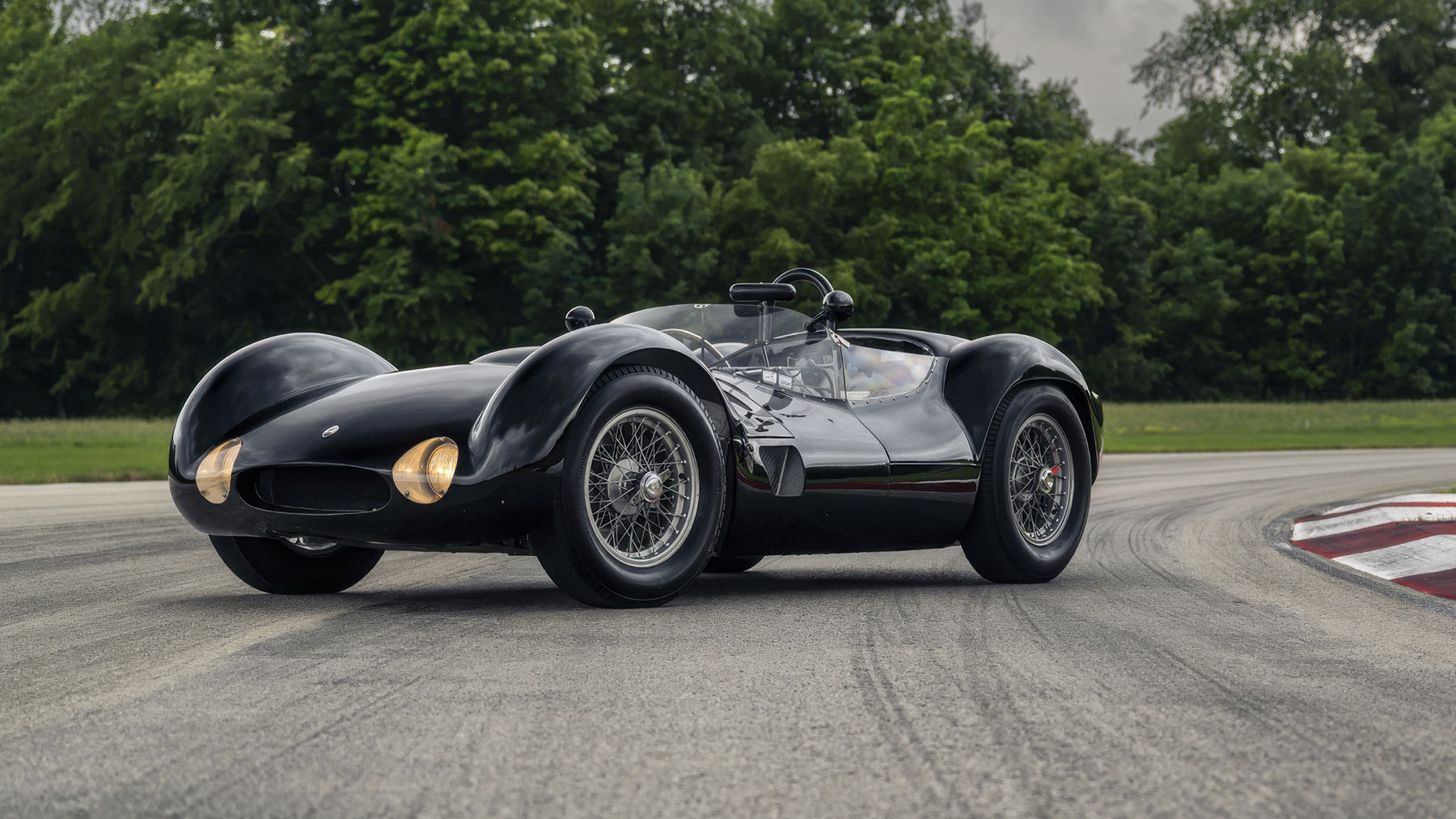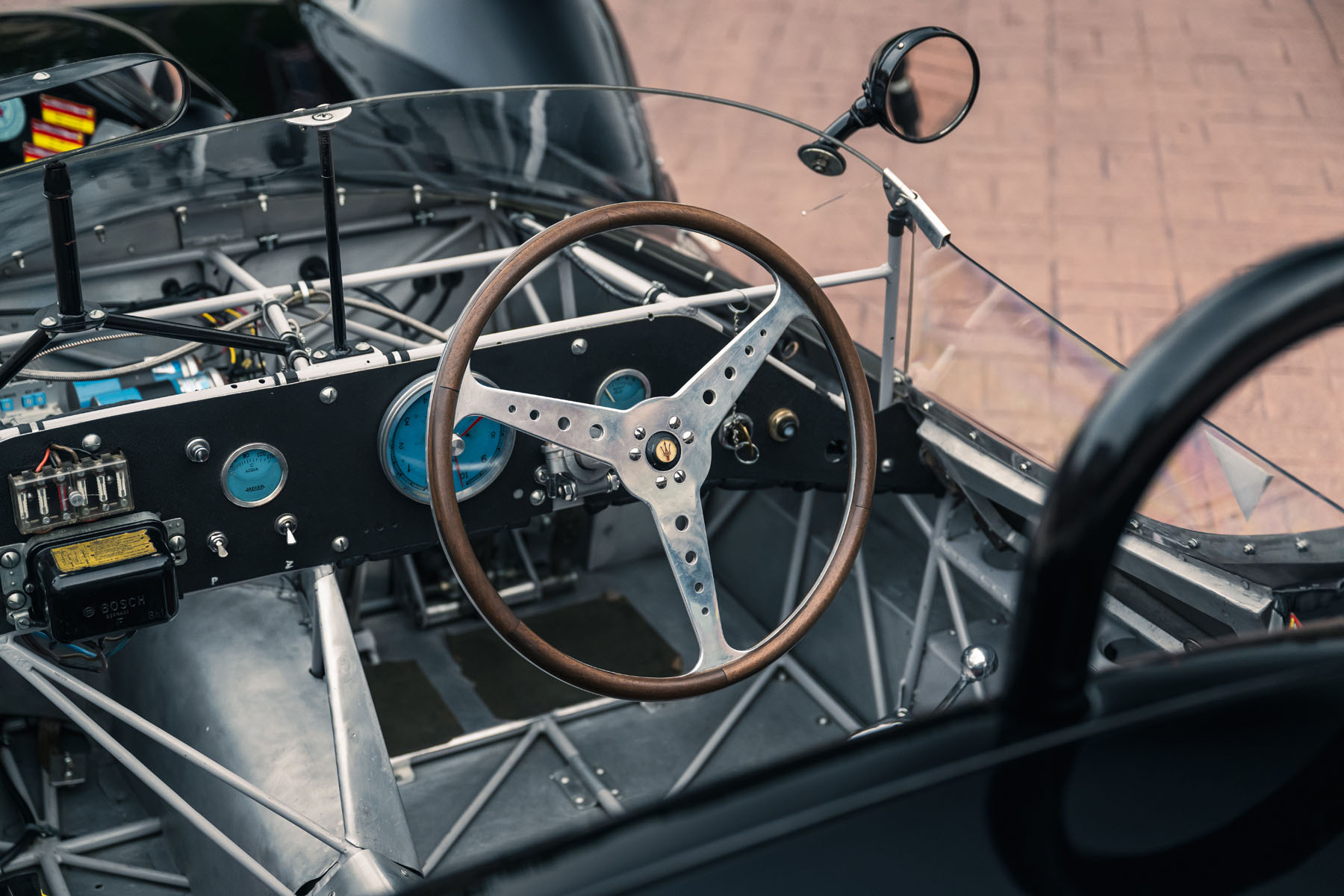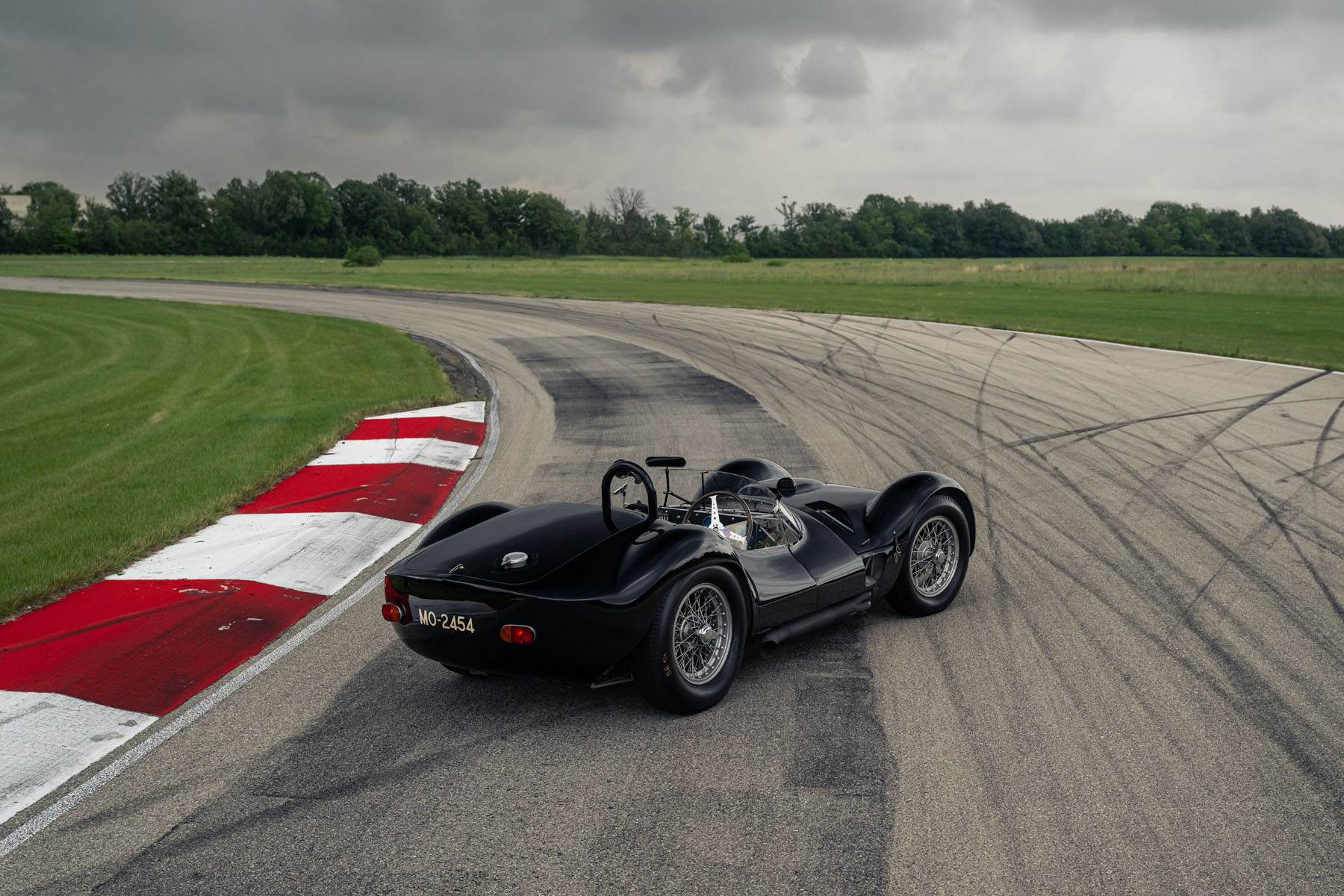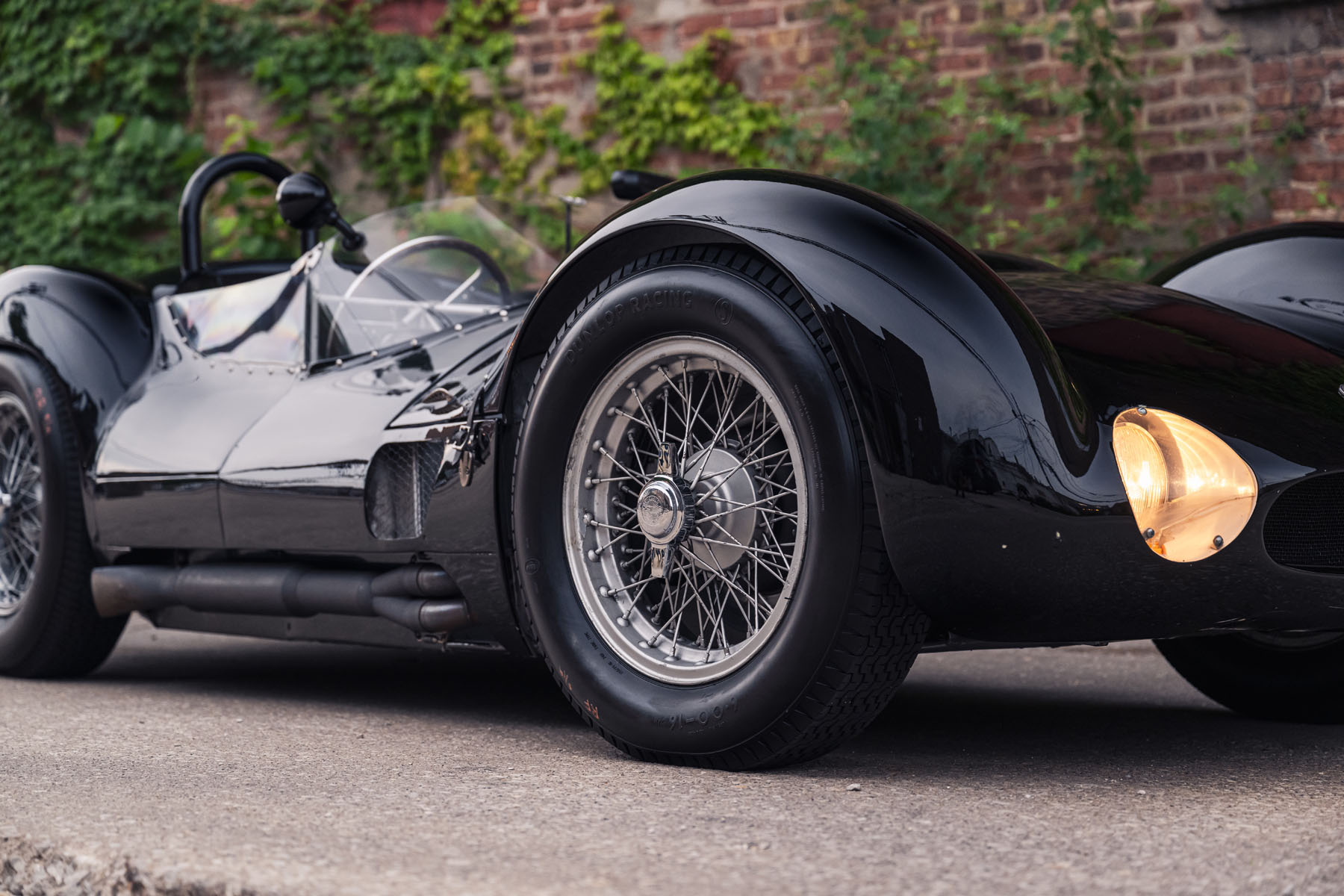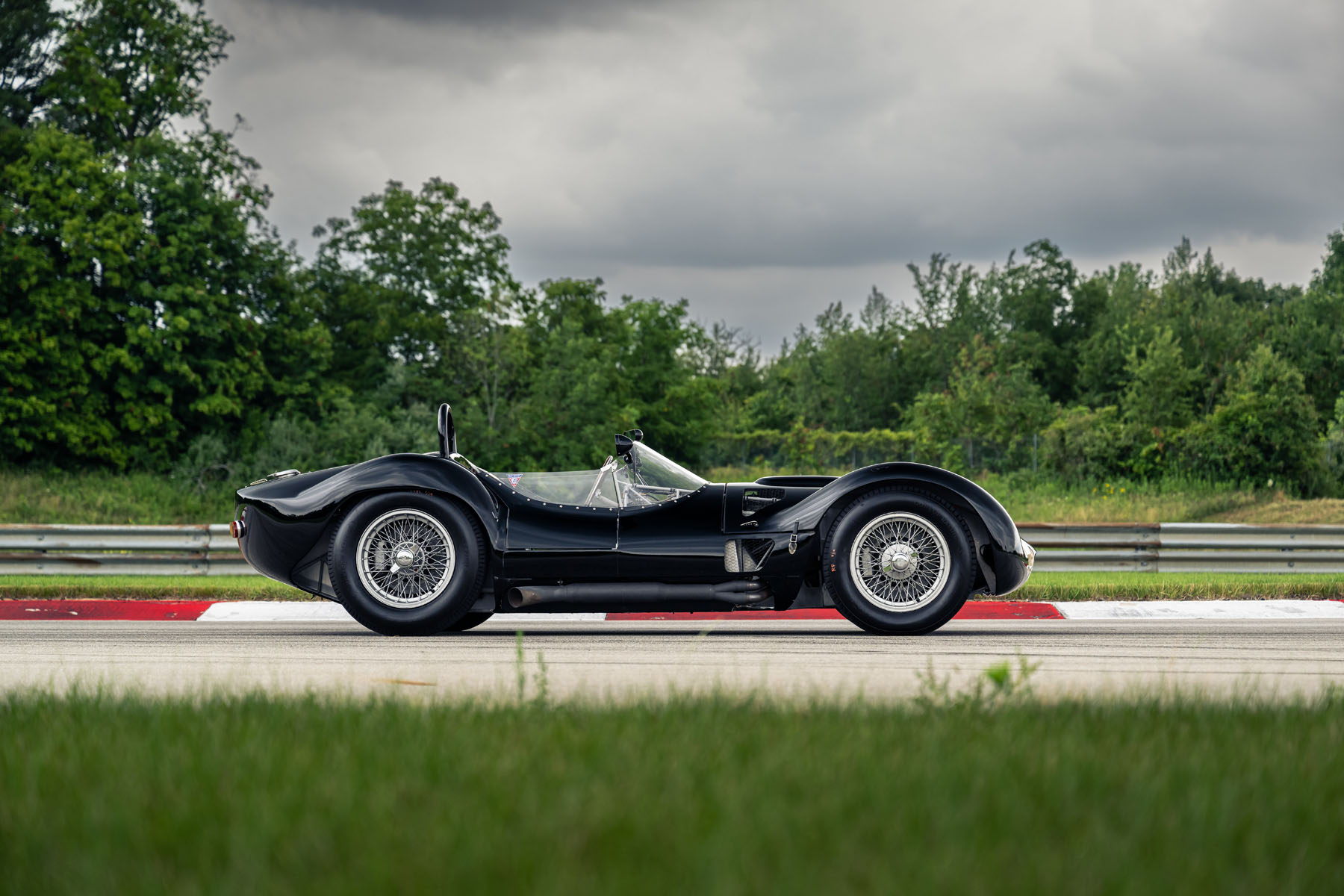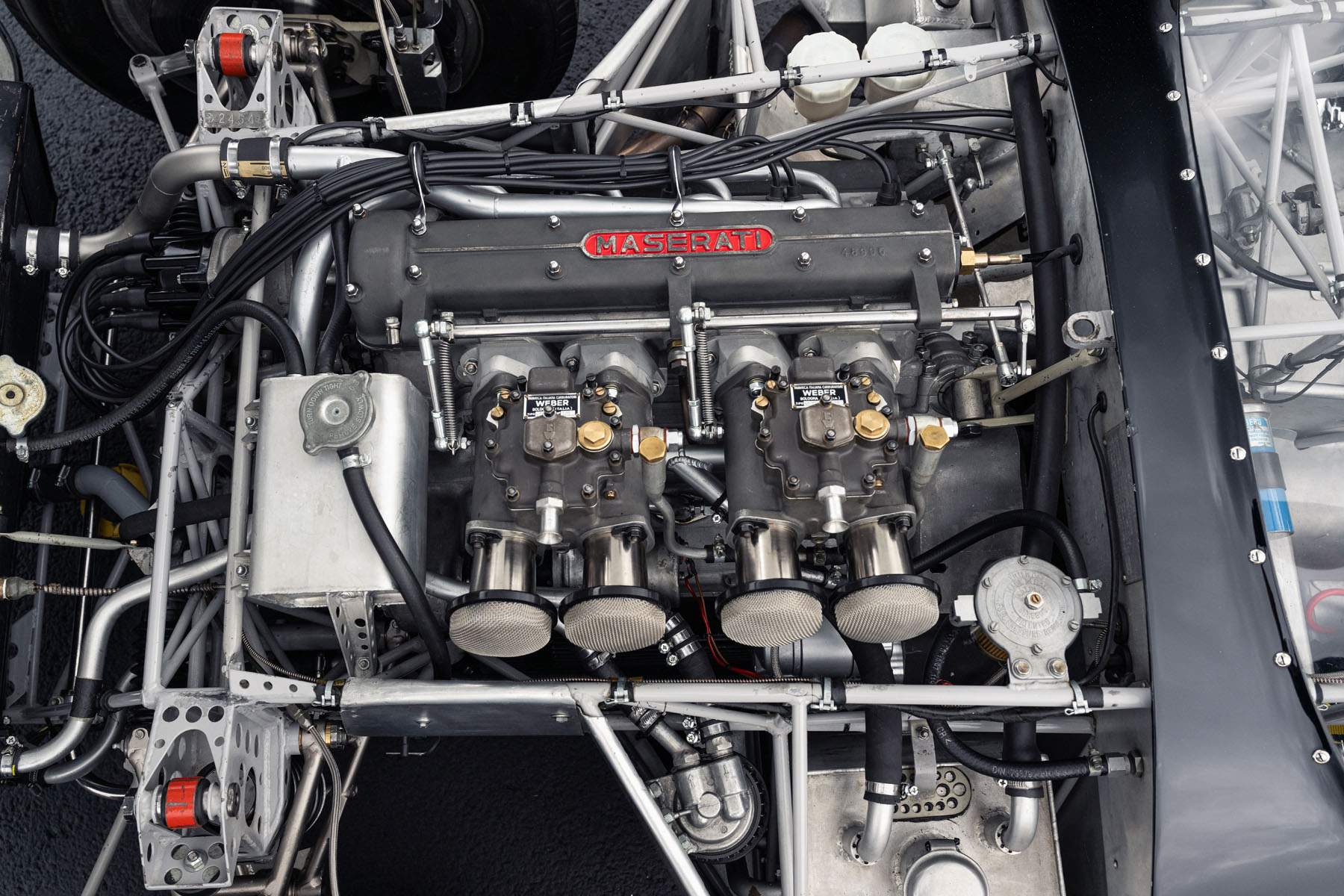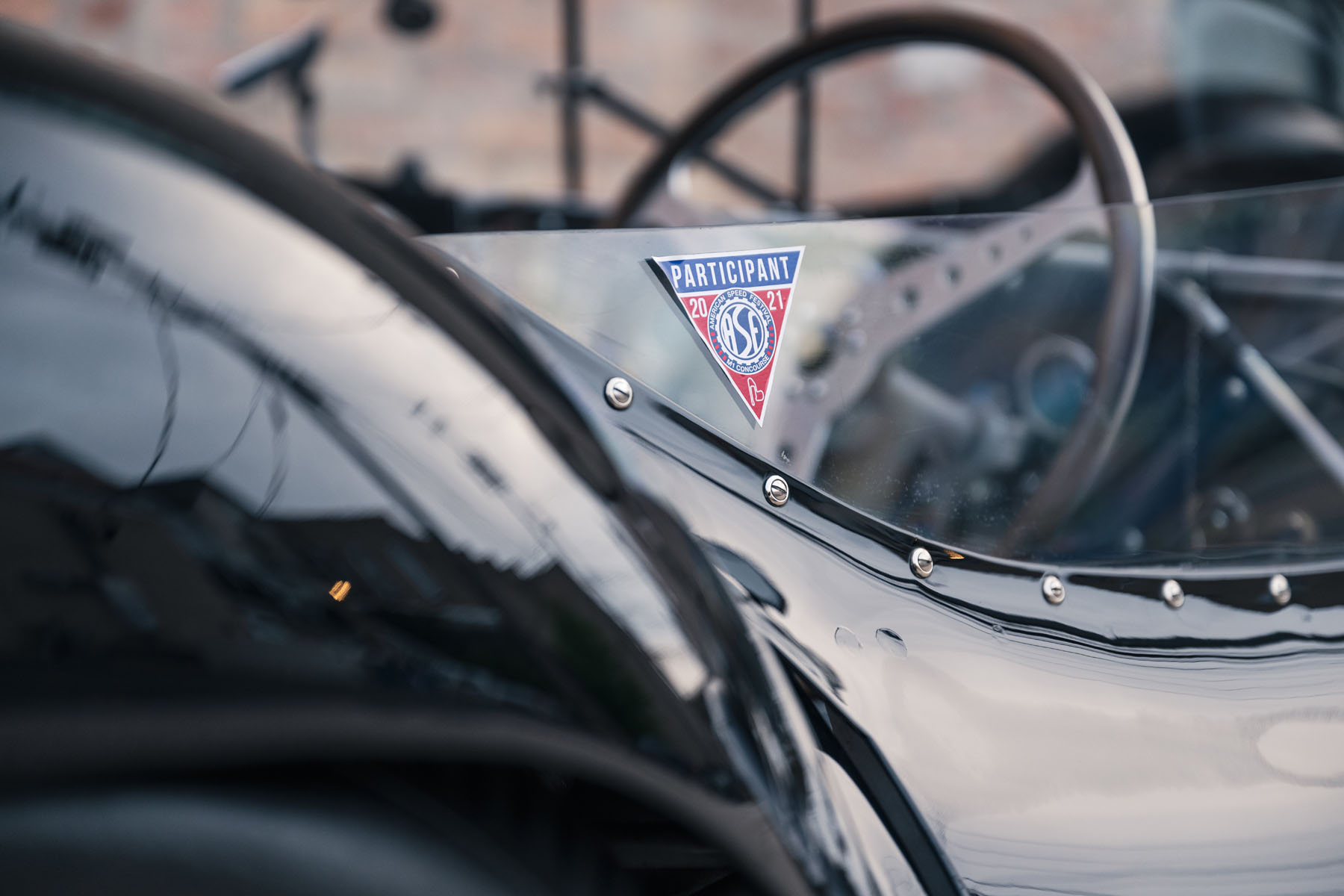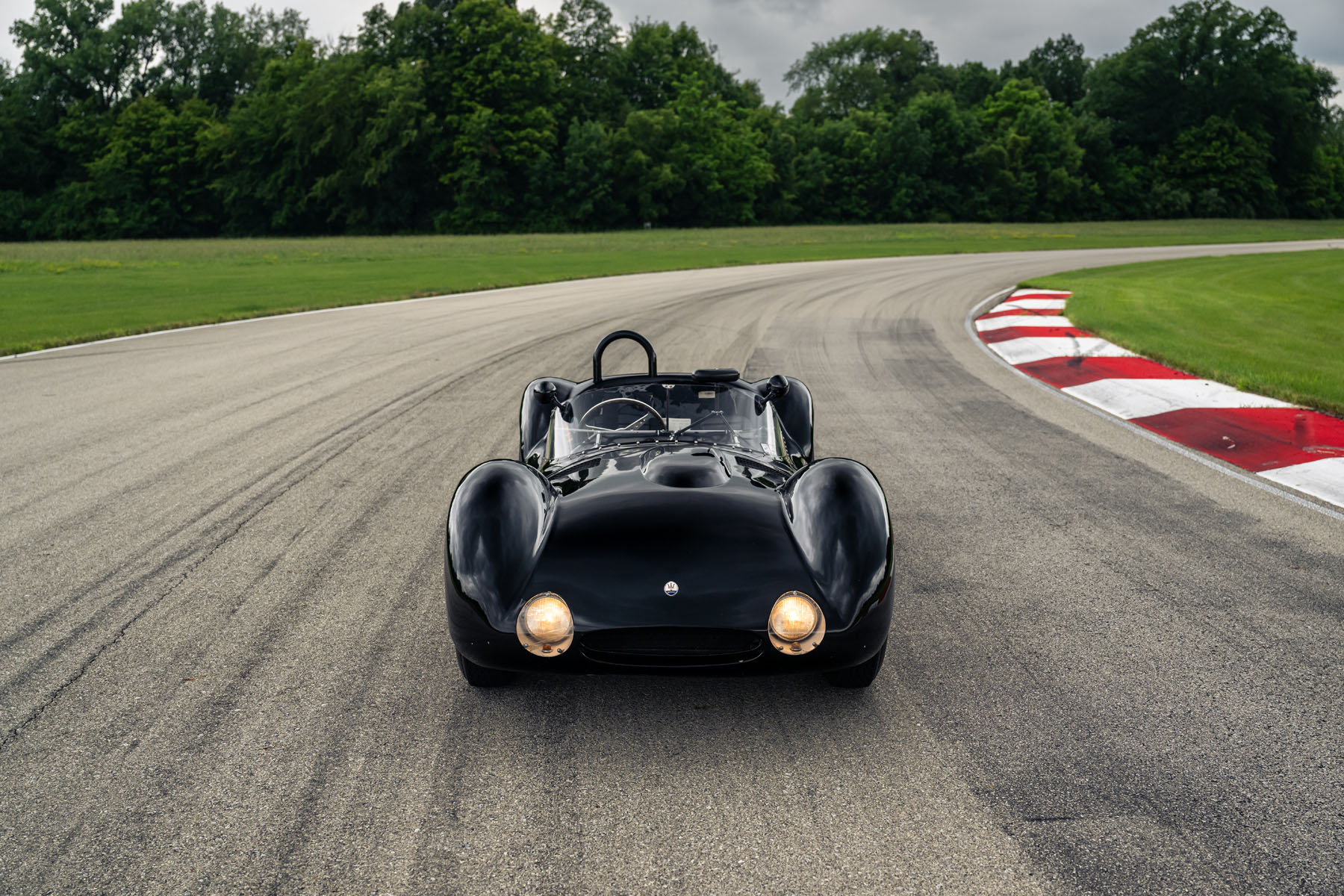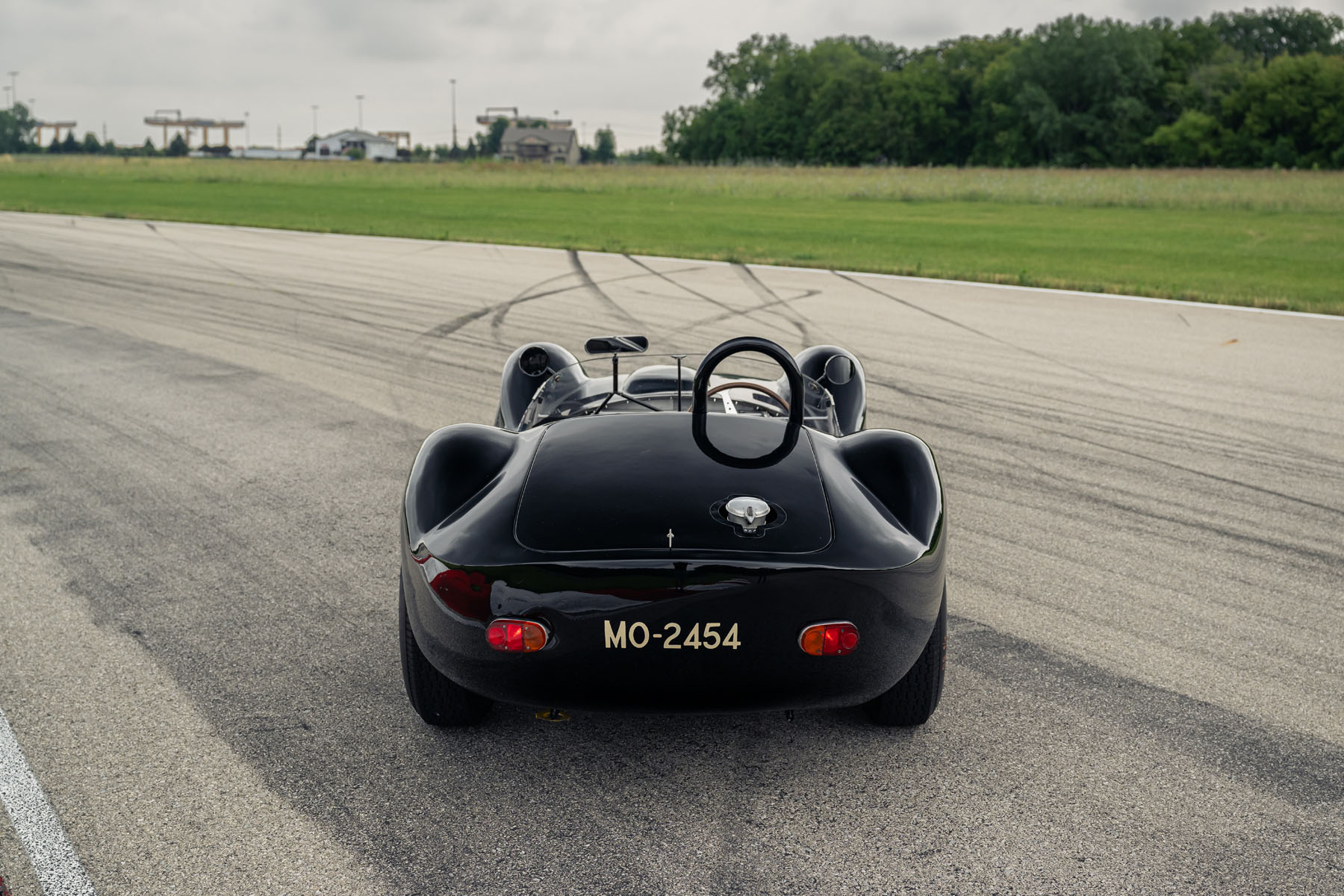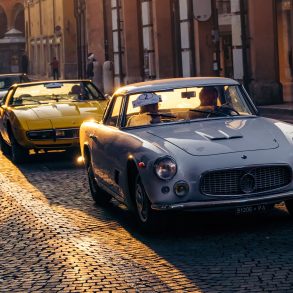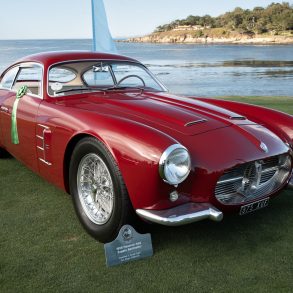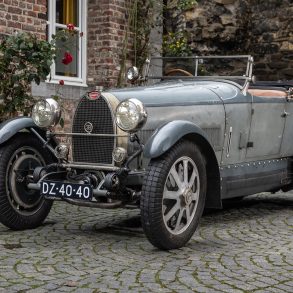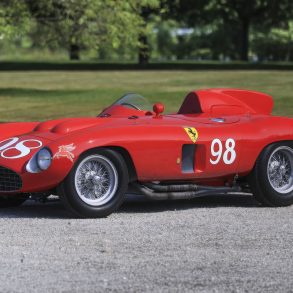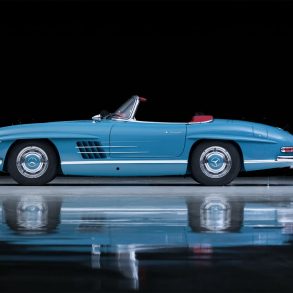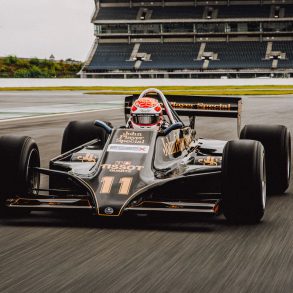Background
By the late 1950s, sports racing cars were becoming increasingly sophisticated, transitioning from traditional front-engine production-based cars to a new generation of highly specialized purpose-built mid-engine machines. Faced with the challenging task of designing an all-new sports car on a shoestring budget, Alfieri courageously created the last of the great front-engine sports racers – and what is today regarded as a masterpiece of industrial design.
The genius of Alfieri’s design lay in its intricate space-frame chassis – an engineering marvel constructed from approximately 200 small-diameter chromoly steel tubes, welded in triangular formations and reinforced in highstress areas. Weighing less than 70 pounds, this chassis earned the new Maserati its “Birdcage” nickname and provided an extremely lightweight platform with exceptional torsional rigidity.
While its chassis represented a radical new direction, the rest of the Birdcage design made use of tried-and-true Maserati components. The car’s independent front suspension and De Dion rear axle were derived from the highly successful 250F Formula 1 car, as was its rear-mounted, five-speed transaxle. Advances in sports car design allowed Alfieri to utilize four-wheel disc brakes, rack and pinion steering, and Koni telescopic dampers at each corner, giving the featherweight Birdcage unmatched cornering and stopping power. This remarkable mechanical package was clothed in equally daring Allegretti coachwork, characterized by its low body line, protruding wheel arches, aerodynamically effective Kamm tail, and steeply raked windscreen, which not only complied with strict FIA regulations, but also offered a glimpse into the Birdcage’s complex inner workings.
As the Tipo 60 was intended for customer use, Alfieri decided to use the proven two-liter, four-cylinder engine from the earlier 200S. To lower the car’s center of gravity, the engine was mounted well behind the front axle, converted to dry sump lubrication, and canted over 45º to the right. After early tests showed that the chassis was capable of handling significantly more power, Alfieri decided to produce a 2.9-liter version of the Birdcage – with 50 additional horsepower – called the Tipo 61. The larger capacity Tipo 61 was extremely popular in North America and gave Maserati a real contender in the FIA World Sportscar Championship, where the Birdcage’s clever design provided an instant advantage on tight, technical circuits.
As Maserati had shuttered its factory racing program after the 1957 season, the fate of the Birdcage was left in the hands of well-heeled privateers like Briggs Cunningham and Lloyd “Lucky” Casner’s Camoradi Racing Team.
Despite the lack of factory backing, the Birdcage proved itself at the highest levels of sports car racing, dominating the Italian hill climb championship, winning the Nürburgring 1000 Km in 1960 and 1961, and capturing the 1960 SCCA D-Modified National Championship. Not only was the Birdcage successful in competition, but its outstanding dynamic qualities made it a favorite among amateur and professional racers alike.
Highlights
- Among the Most Iconic and Sought-After of All Maserati Racing Cars
- Ultimate-Specification Tipo 61 Birdcage – One of Only 17 Examples Built
- Campaigned by American Racers Loyal Katskee and Don Skogmo Through 1963
- Raced in Period at the Cuban Grand Prix, Bahamas Speed Week, and Pikes Peak Hill Climb
- Formerly Owned by Noted European Collectors Giulio Dubbini and Carlo Vögele
- Maserati Classiche Certified; Accompanied by Period Tipo 61 Engine (Disassembled) and Spare Reproduction Engine
Technical Specs
- 2,890 CC DOHC Twin-Plug Inline 4-cylinder Engine
- Twin Weber 45 DCO3 Carburetors
- Estimated 250 BHP at 6,800 RPM
- 5-Speed Manual Transaxle
- 4-Wheel Hydraulic Disc Brakes
- Front Independent Suspension with Coil Springs
- Rear De Dion Axle with Transverse Leaf Spring
Chassis 2454
According to Maserati records, this Tipo 61, chassis 2454, was completed on November 9, 1959, making it the third of just 17 examples built. Originally finished in black with red upholstery, the Birdcage was sold new to Loyal Katskee, an Omaha, Nebraska-based British car dealer, who had been campaigning a Ferrari 750 Monza since 1956.
On November 13, 1959, #2454 was flown from Italy to Miami, Florida, arriving in time for Katskee to debut the spectacular new Maserati at the annual Bahamas Speed Week in Nassau. Despite the new car suffering from a failing De Dion bridge, Katskee managed to place 11th Overall in the Governor’s Trophy and 16th Overall in the Nassau Trophy.
After Nassau, Katskee repainted the Birdcage white with fluorescent orange racing numbers. In February 1960, he entered it in the first La Libertad Grand Prix in Havana, Cuba. Facing a competitive field that included several Porsche 718 Spiders, a Ferrari TR59 driven by Pedro Rodriguez, and another Tipo 61 Maserati driven by Stirling Moss, Katskee had 2454 running in 4th Place when an engine failure forced his retirement after just 16 laps.
Throughout the remainder of the 1960 season, Katskee campaigned his Birdcage in USAC races across North America, beginning with Continental Divide in June and finishing the season that October following the Los Angeles Times Grand Prix at Riverside and the USAC Pacific Grand Prix at Laguna Seca. His best result with 2454 occurred at Road America, where he placed 3rd Overall behind two long-tail Birdcages.
Following the 1960 season, Katskee sold 2454 to Donald Skogmo of Minneapolis, an heir to the Gamble-Skogmo merchandising chain. Skogmo, who already owned another Birdcage and would go on to acquire at least two others, campaigned his fleet of Maseratis under the “Dirty Bird Racing Team” banner throughout the early 1960s.
For 1961, Skogmo installed a new engine in 2454 and entered it in a variety of events, from local SCCA races to the famous Pikes Peak International Hill Climb, finishing the racing season at Nassau. After two additional Birdcages joined Skogmo’s team for the 1962 season, 2454 was primarily kept as a backup car, taking part in a few additional SCCA races throughout the Midwest and one final edition of the Bahamas Speed Week before retiring after the 1963 season.
Racing History
- Nassau Governor’s Trophy, 1959, Katskee, No. 12 (11th Overall)
- Cuban Grand Prix, February 1960, Katskee, No. 17 (DNF)
- USAC Continental Divide, Colorado, June 1960, Katskee, No. 12 (DNF)
- USAC Road America, Wisconsin, July 1960, Katskee, No. 12 (3rd Overall)
- USAC Los Angeles Times Grand Prix, October 1960, Katskee, No. 12 (DNF)
- USAC Pacific Grand Prix at Laguna Seca, Heat 1, October 1960, Katskee, No. 12 (14th Overall)
- USAC Pacific Grand Prix at Laguna Seca, Heat 2, October 1960, Katskee, No. 12 (DNF)
- SCCA Wilmot Hills, Wisconsin, May 1961, Skogmo (2nd Overall)
- USAC Hoosier Grand Prix, Heat 1, June 1961, Skogmo, No. 31 (11th Overall)
- USAC Hoosier Grand Prix, Heat 2, June 1961, Skogmo, No. 31 (8th Overall)
- USAC Continental Divide, Heat 1, Colorado, July 1961, Skogmo, No. 31 (7th Overall)
- USAC Continental Divide, Heat 2, Colorado, July 1961, Skogmo, No. 31 (DNF)
- USAC Pikes Peak International Hill Climb, July 1961, Skogmo, No. 31 (8th in Class)
- SCCA Metropolitan Stadium, Minnesota, July 1961, Skogmo, No. 3 (1st Overall)
- Nassau Governor’s Trophy Prelim, December 1961, Skogmo, No. 61 (13th Overall)
- Nassau Governor’s Trophy, December 1961, Skogmo, No. 61 (8th Overall)
- Nassau International Trophy, December 1961, Skogmo, No. 61 (16th Overall)
- SCCA Road America June Sprints, Wisconsin, June 1962, Skogmo, No. 31 (15th Overall)
- SCCA Road America 500, Wisconsin, September 1962, Skogmo/Beckett, No. 31 (DNF)
- SCCA Rosemount, Minnesota, June 1963, Skogmo (1st Overall)
- SCCA Road America June Sprints, Wisconsin, June 1963, Skogmo, No. 34 (DNF)
- SCCA Lynndale Farms, Wisconsin, September 1963, Skogmo, No. 32 (6th Overall)
- Nassau Governor’s Trophy, December 1963, Skogmo, No. 31 (DNF)
Second Life
In 1965, Don Skogmo advertised 2454 for sale, asking $2,300 for the Maserati, which, by this point, had neither an engine nor transaxle fitted. The aging Tipo 61 was sold to a new owner in Florida, then passed through a subsequent owner in New York, before being purchased by an Englishman around 1970. Under his ownership, 2454 received a sympathetic restoration and was fitted with a two-liter engine and four-speed transaxle from a Maserati 300S. In the mid-1970s, the Birdcage was sold back to the US; renowned Italian collector Giulio Dubbini acquired it from there in 1978.
Based in Padova, Italy, Dubbini was well known for his impressive stable of sports and racing cars, which included important Alfa Romeos, Maseratis, and many of the finest Ferraris, including a 250 Testa Rossa, 250 MM Berlinetta, 500 TRC, and 250 GT SWB Berlinetta. In addition to his extraordinary automotive holdings, Dubbini was an avid enthusiast who helped organize many historic events including the Coppa d’Oro delle Dolomiti Storica. Chassis 2454 remained in his impressive collection for the next decade, during which time it was fitted with a correct-type Tipo 61 engine and five-speed transaxle.
In 1989, after Mr. Dubbini’s passing, 2454 was sold to Swiss collector Karl Blöchle. An avid car collector and fine artist specializing in automotive models, Mr. Blöchle campaigned the Tipo 61 in European historic events through 1997, when it was sold to German collector Hein Gericke.
In 2000, respected Swiss collector and historic racer Carlo Vögele acquired 2454. Under his ownership, the Maserati was entrusted to Capricorn Group, the German engineering company well known for producing high-quality restorations and reproduction racing engines. The restoration of the Tipo 61 was performed with the goal of competing at the highest levels of historic racing and Mr. Vögele did just that, entering it in several rounds of the Shell Ferrari Historic Challenge.
During his ownership, Mr. Vögele also had 2454 inspected and certified by Maserati Classiche. According to the accompanying Maserati Classiche Certificazione di Autenticità, this Birdcage retains its original chassis and bodywork, and has a correct-type engine and transaxle. It is believed that this Tipo 61 is one of as few as two examples certified by Maserati Classiche before the company ended the program.
Mr. Vögele owned 2454 until 2011, when it was sold to German collector Klaus Werner, who continued to race it in historic events at Spa, Nürburgring, and Goodwood.
Since 2012, the Birdcage has been a fixture in a prominent North American collection, benefiting from meticulous maintenance and sparing use. Soon after acquiring the Maserati, the consignor sent it to the renowned Canepa Motorsport of Scotts Valley, California, for a thorough inspection and race preparation. Detailed photos and invoices on file confirm that 2454 was carefully disassembled, inspected, and repaired as needed to prepare it for its debut at the 2014 Monterey Historic Automobile Races at Laguna Seca. For vintage racing purposes, the Birdcage is currently fitted with a reproduction engine built by UK-based Maserati specialist Steve Hart. Another reproduction race engine and the disassembled period Tipo 61 engine, no. 2477, accompany the car at auction.
Gooding & Co
Go HERE for more information.
Above content © 2024 Gooding & Co reviewed and edited by Rex McAfee



